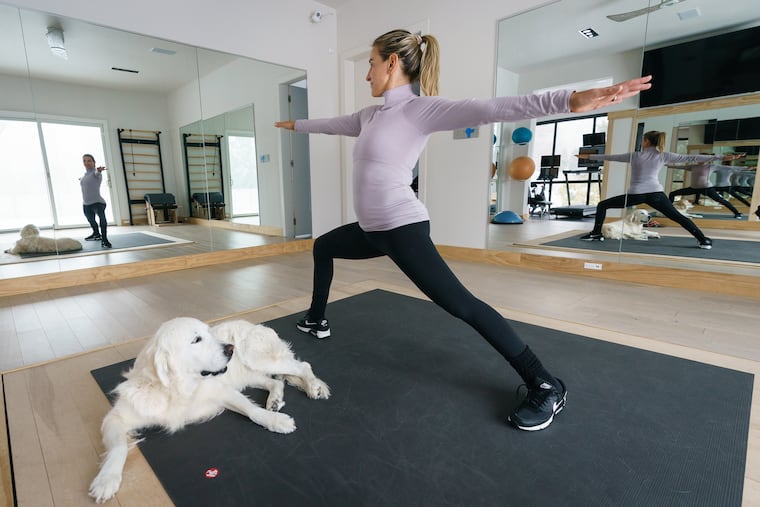Millennial homeowners spent tens of thousands on pandemic renovations
They also spent more — an average of $40,600 compared to $10,000 spent by Generation X and $11,000 among baby boomers, the 2022 James Hardie Homeowner Survey found.

Scot Stone and his wife, Carrie, loved the house in Meadowbrook where they moved in 2018, but the 1990s decor just didn’t fit their style. About two years later, they began an extensive renovation, gutting much of the home to create the modern design they wanted.
“The pandemic forced us to talk about the decor more and get us more excited about the renovations,” said Scot, 40, a senior vice president at Medical Products Laboratories based in Northeast Philadelphia. “Because we were home so much, we could be together and actually get stuff done.”
The couple removed several interior walls to create an open floor plan. A quarter of their $1 million budget went into a new modern kitchen with a white quartz island, a stone-and-glass backsplash behind a custom hooded vent, high-end appliances, and cabinetry from Italy. They added a second, full prep kitchen just behind the main kitchen and created a primary bathroom with two separate toilet rooms, a freestanding tub, and a shower made of Dekton, a blend of quartz, porcelain, and glass. Exterior renovations included painting and installing a heated driveway.
The Stones were among the many millennial homeowners who made investments in their new homes during the pandemic. According to the 2022 James Hardie Homeowner Survey, sponsored by the global building materials company, millennials, now the largest cohort of homebuyers, were the most likely of all generations to have made COVID-era renovations: 75% compared with 65% of Generation X and 55% of baby boomers. Millennials also spent more — an average of $40,600 compared with $10,000 spent by Generation X and $11,000 among baby boomers.
“Not only were we getting more frequent customers in that age group, we were also getting customers spending a lot more,” said Noula Karagiorgos, business development manager at Cosmos Marble and Granite in Huntingdon Valley.
The survey found that renovations by millennials significantly exceeded those of other groups, particularly in interior spaces, said Eleni Vydra, James Hardie senior brand marketing manager, based in Chicago.
“Millennials lead in renovating the bathroom (63%), bedroom (54%), living room (52%), and kitchen (50%), and we anticipate exterior upgrades and outdoor spaces are not far behind,” she said.
» READ MORE: Haddonfield couple’s new outdoor kitchen and fireplace help them cope with the pandemic
In the James Hardie survey, 80% of millennials said they are willing to use bold colors in their exterior renovations, whether in outdoor furniture, siding or windows. Bright colors are also popular indoors, with bold accent walls, cabinets in greens and blues to bring out the like-colored veins in quartz countertops, and gold faucets.
“Millennials want to make their homes their own, and they want the world to see it,” Vydra said. “During the pandemic, we spent more time outside where the home exterior became the backdrop of our lives.”
For millennials, their first real estate investment is less likely than previous generations to be a typical starter home, she said. They tend to see the purchase as a longer-term investment — potentially a forever home — so they choose something a bit larger.
Those homes often need updates or renovation, plus working from home during the pandemic has revealed other needs. And many homeowners have more money to spend because of savings from skipping commutes and vacations.
» READ MORE: Homeowners continue to adapt their space as pandemic restrictions come and go
“There are two basic types of projects: need versus want,” said David Haas, cofounder and chief operating officer of PowerPay, a home improvement financing provider. “Need are things like, ‘I need a new roof,’ and want is, ‘I can’t stand my kitchen, and I want to remodel it,’” he said. “Early in the pandemic, we saw more need-based projects.” Now, he said, two years into the pandemic, “we are seeing more want-based projects.”
Where older consumers might have done partial renovations, millennials did full guts of kitchens and bathrooms, Karagiorgos said. They preferred a more modern look, which included higher-priced items such as a $5,000 to $8,000 white or light-gray quartz countertop as opposed to a $3,000 darker granite top.
Karagiorgos also found millennials more likely to exceed their budgets than other age groups. “Say they come with a $3,000 budget,” she said. “They might find something that’s $5,000 or $6,000, and they find a way to purchase what they like.”
That was true for the Stones. Though they didn’t increase their overall budget, they chose what they loved and put off other projects.
“We found ourselves generally choosing the more expensive option rather than the less expensive option,” Scot said. “We didn’t sacrifice what we did, just held off on doing other things we wanted to do that are still unfinished.”
Have you solved a decorating, remodeling, or renovation challenge in your home? Tell us your story by email (and send a few digital photographs) to properties@inquirer.com.